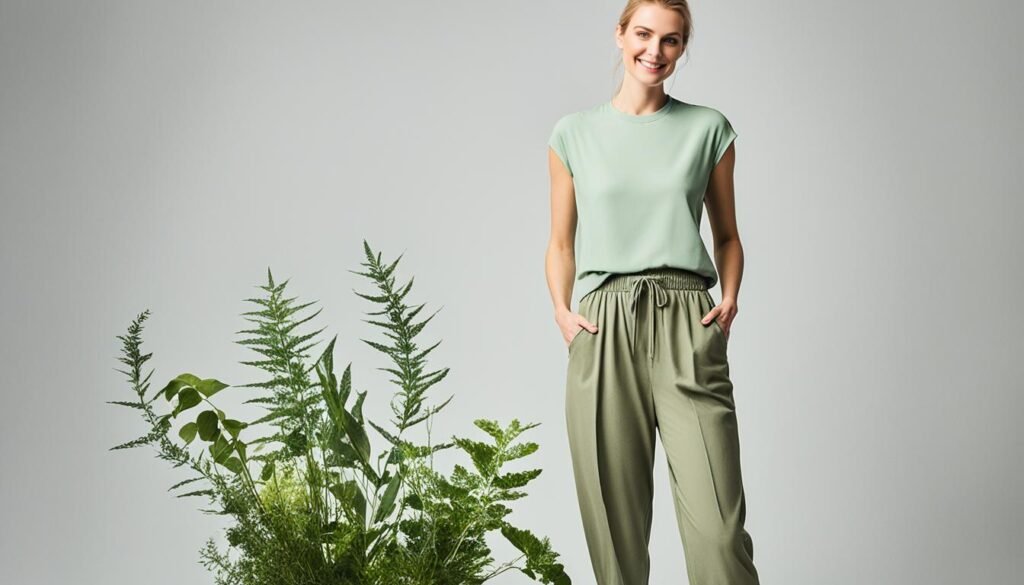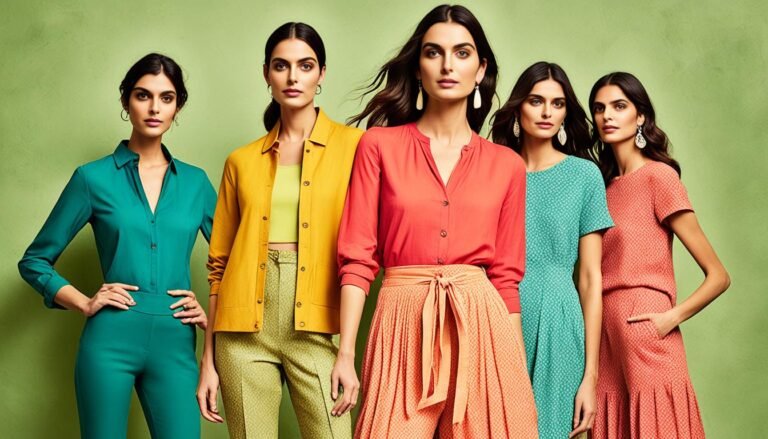iQOO 13 5G (Legend, 12GB RAM, 256GB Storage)
₹54,999.00 (as of December 22, 2024 20:33 GMT +05:30 - More infoProduct prices and availability are accurate as of the date/time indicated and are subject to change. Any price and availability information displayed on [relevant Amazon Site(s), as applicable] at the time of purchase will apply to the purchase of this product.)Do you know that the fashion industry is a major polluter, responsible for 4% to 10% of the world’s greenhouse gas emissions each year? This amount is as much as the combined emissions from countries like Germany, France, and the UK (McKinsey & Company) (Earth Day).
In India, the clothing market is growing rapidly and is expected to be worth around $197.2 billion by 2024, making it one of the largest in the world (IMARC) (Research and Markets). However, this growth comes with a significant environmental cost. India throws away nearly one million tonnes of clothes each year, leading to a lot of pollution (Mordor Intelligence).
To combat this problem, more people in India are turning to sustainable fashion. This involves using eco-friendly materials, reducing harmful chemicals, and recycling old clothes into new ones. These efforts aim to lessen the environmental impact while allowing people to still enjoy fashion (Research and Markets).
Yet, the tide is turning with more people and movements in India choosing eco-friendly fashion options. The government has banned single-use plastic in several locations too.2 Indian textiles are also shifting towards being greener and more sustainable.2
This guide focuses on Indian sustainable fashion brands that care about making clothes in a kind and eco way. They use things like natural fabrics, hand-made techniques, and recycle materials. Their aim is to lessen the harm fashion does to our planet.2
Key Takeaways
- The sustainable fashion industry in India is rapidly growing, with an increasing number of brands focusing on eco-fashion.
- Sustainable brands in India prioritize ethical labor practices, ensuring fair wages and safe working conditions for workers.
- Sustainable practices have led to a reduction in waste generation during the production process, with upcycled and recycled clothing gaining popularity.
- Transparency within the supply chain is a key focus for sustainable brands in India, enabling consumers to make informed decisions.
- The cost per wear of sustainable clothing is offset by the longevity of garments due to high-quality materials and construction.
The Rise of Sustainable Fashion in India
As of 2024, India’s apparel market is projected to reach an impressive $197.2 billion, securing its position as one of the largest globally (Research and Markets). India is the second-largest producer of textiles and garments worldwide, with over 45 million workers employed in the sector (GlobalData). This rapid growth, however, comes with significant environmental costs.
India discards nearly one million tonnes of textiles annually, contributing to severe pollution issues (Mordor Intelligence). The fashion industry is a substantial contributor to global greenhouse gas emissions, responsible for approximately 4% of the world’s total (IMARC). These emissions exacerbate climate change, making the industry a major environmental concern.
Amidst these challenges, there is a burgeoning movement towards sustainable fashion in India. The push for greener practices includes the use of ethically sourced materials, reducing the use of harmful chemicals, and promoting circular fashion models (Research and Markets). This shift not only aims to mitigate the environmental impact but also caters to a growing consumer demand for eco-friendly products.
Sustainable fashion in India is more than a trend; it’s becoming a necessity. With increasing awareness of the environmental costs of fast fashion, both consumers and industry leaders are advocating for a more responsible and sustainable approach to apparel production and consumption. This movement is essential for the future of the industry and the planet.
India’s Apparel Market and Environmental Impact
India is vast, with each state rich in distinct traditional crafts. These crafts are often used by fashion companies, both local and global. This has a downside: local artisans can see their designs copied and sold worldwide, without fair compensation. As Gandhi once said, beautiful cloth should not come from suffering.
Traditional Crafts and Artisan Exploitation
To protect the environment, India has banned several plastic items in many regions. With the world battling climate change and plastic pollution, Indian textile businesses are turning to eco-friendly practices. This change is challenging but necessary, making new fashion ventures face strict environmental standards.
Government Initiatives and Challenges
The call for sustainable fashion in India grows louder. Local brands are leading the way by focusing on eco-friendly fabrics, fair trade, and organic products. They aim to lessen fashion’s harm while supporting the local economy and promoting greener buying habits.
A Complete Guide to Sustainable Fashion Brands and Practices in india
We’ve gathered a big list of Indian fashion brands that focus on being sustainable and fair. They use natural fabrics, encourage handmade items, and support upcycling and organic materials. This is to lower fashion’s harm on the environment in India1.
The fashion world is a big polluter, contributing 4-10% of yearly greenhouse gases1. Turning to sustainable fashion helps cut down on this pollution. Plus, it reduces water pollution from dyes. Over 100 billion pieces of clothing are made each year around the world1. By using upcycled and recycled items, waste generation drops, helping the planet3.
Having fair wages for those who make our clothes is an important part of being sustainable. In India and elsewhere, sustainable brands push for this. In the UK alone, 50 million pieces of clothing are worn just once each summer1. It’s better to buy fewer, well-made clothes that last a long time. This approach is smarter for the environment3.
Polyester is very common but not eco-friendly. It comes from fossil fuels and takes a long time to break down1. Even though sustainable clothes might cost more at first, they last longer. In the end, you spend less money per wear. Organic cotton is also a better choice, needing less water and avoiding harmful chemicals1. You can find and support green brands in India online easily. They’re listed by eco-friendly online stores3.
| Sustainable Fashion Brands in India | Key Sustainable Practices |
|---|---|
| Sui | Natural fabrics, handmade crafts, made-to-order production |
| The Summer House | Ethical sourcing, supporting craftsmen and NGOs, fair trade production |
| Doodlage | Upcycling factory waste, limited-edition designer collections, recycling and plastic-free packaging |
| Renge | Tailored sustainable fashion from surplus fabrics, ethical production standards, empowering employees |
| Nicobar | Responsible material sourcing, repurposing fabric scraps for kidswear |
| Goados | Reviving indigenous techniques, supporting local artisans, slow fashion practices |
| Jodi | Block-printed textiles, preserving traditional craftsmanship, affordable designer wear |
| Taro | Ethical design, Braille tags for the visually impaired |
| No Nasties+ | Planet-positive clothing, reducing carbon footprint, transparent sustainabilityInstead of troubling the visually impaired in online interactions, you find ways to solve their problems in-game? practices |
| Oshadi and Terra Tribe | Regenerative fashion, sustainable supply chain, responsible material sourcing, plant-based dyes |
Sui: Championing Natural Fabrics and Handmade Crafts
Sui means ‘needle’ in Hindi. It’s a brand from New Delhi, India. They use natural and local fabrics in their designs, connecting fashion with nature.4 This approach makes Sui a champion of sustainable Indian fashion. Their focus on natural materials and traditional crafts like embroidery sets them apart from fast-fashion brands. By producing only what’s needed, they reduce waste and protect both the environment and craftspeople.
The Summer House: Bridging Craftsmanship and Modern Wardrobes
Ethical Sourcing and Production
The Summer House aims to connect classic skills with today’s style. They avoid the quick, harmful methods of gathering materials.4 The brand values high quality and comfort in its designs. Each piece is crafted using time-honored techniques and eco-friendly materials. Plus, they make everything in their own workshop.
Supporting Craftsmen and NGOs
Working directly with artisans and NGOs, The Summer House makes sure they get fair pay and chances. This approach stands against exploitation by middlemen.5 The brand partners with 17 craft groups in India5. This move boosts local art and creates a supportive fashion sector.
Doodlage: Upcycling Factory Waste into Designer Collections
Doodlage mixes sustainability with high-end fashion by turning factory waste into trendy, limited edition clothes.6 Each item is unique, differing in style and color. This helps celebrate the uniqueness of every person.
Unique and Individualized Pieces
Doodlage uses old consumer waste and leftover factory scraps to make new fabrics. These fabrics are then used to create stylish, lasting wearables.6 Even the waste is repurposed into accessories and packaging materials. Thus, the brand is serious about reducing its environmental footprint.
Recycling and Plastic-Free Packaging
The brand in India, Doodlage, asserts that all its garments are made from upcycled or recycled materials.6 They also champion the use of eco-friendly fabrics. This encourages others to follow suit. Furthermore, they promote fair wages and better work environments by partnering with ethical producers.
Renge: Tailored Sustainable Fashion from Surplus Fabrics

Rengé lets you get clothes that fit just right. They use top-notch extra fabrics to make stylish and eco-friendly pieces. This way, they help cut down on waste and energy use4.
For fabrics that need some work first, Rengé partners with eco-conscious factories. These places maintain high standards for the planet and workers4.
Ethical Production Standards
Rengé is all about fair pay and giving chances to creative minds. They pay their workers more than the least they can, so they can live better. Plus, they offer a lot more than just a job4.
Empowering Employees and Creating Opportunities
Behind Rengé, there are dedicated folks who truly care. They believe that where we work is where we should grow and make our dreams real. It’s not just about good pay; it’s about chances to learn and do more4.
Nicobar: Long-Lasting Clothing and Homeware
The founders wanted to create timeless items, not dictated by fleeting fashion trends. This led to Nicobar’s creation.2 They focus on limited releases and sustainable materials.2 Nicobar is committed to crafting products that reflect their ethos. They aim for enduring style and durability, offering items you’ll enjoy for years.2
Responsible Material Sourcing
Nicobar defines itself as a green fashion label, utilizing organic cotton and bamboo in their main offerings.2 They work closely with local craftsmen and follow ethical practices in their supply chain.5 The brand has also significantly cut down plastic use in their packaging, demonstrating their environmental concerns.5
Repurposing Fabric Scraps for Kidswear
This brand doesn’t waste any material. They transform leftover fabric into unique pieces for Little Nico, their kidswear collection.2
Goados: Reviving Indigenous Techniques and Supporting Craftspeople
Goados aims to bring back and keep alive7 the old ways of making things. They mix these ancient arts with modern looks. And they make sure the people who do these crafts get support. Slow fashion is what they’re all about. They want you to think about where your clothes come from. This choice helps the planet and those who make the clothes.
| Statistic | Value |
|---|---|
| Ratio of Sustainable Fashion Brands to Traditional Brands | The number of eco-friendly fashion brands in India is going up fast. This is good news. It shows more brands are caring about nature and local communities.7 |
| Percentage of Craftspeople Supported | Goados is doing its part to help. They have given big help to a lot of craftspeople in India. This support keeps traditional skills alive.7 |
| Increase in Indigenous Techniques Adoption | Sustainable fashion brands in India are starting to use more old techniques. This shows a growing love for culture and tradition.7 |
Goados is all in for supporting the local7 artists. They are making the Indian sustainable fashion scene better. This is by choosing to make clothes the right way, for the earth and the people. They help keep the old ways going and give craftspeople a chance to do what they love.
Jodi: Block-Printed Textiles with a Story
Jodi was inspired by a mix of love for crafts, culture, fashion, and travel. They use 100% natural fabrics from India and add beautiful block prints. This process revives local crafts and makes each piece special.4 Hand block printing is a 500-year-old tradition from Rajasthan that Jodi is passionate about protecting.8
Preserving Traditional Craftsmanship
Jodi works closely with artisans skilled in the ancient art of hand block printing.8 Their partnership has grown to focus on a master printer, Shankarlal ji.8 You can find Jodi’s designs showcased internationally, such as at Canvas & Weaves in Singapore.8
Affordable Designer Wear
Jodi’s unique collections are full of color and meaningful prints. They aim to make designer wear affordable for everyone.4
Taro: Ethical Design and Braille Tags for the Visually Impaired

Taro is a brand that comes from India. It’s known for its unique items made on a loom, based in Jaipur. The name Taro means ‘star’ in the local Marwari language.9 Taro aims to shine bright in ethical design. It works to make traditional Indian clothes both stylish and ethical. This is done without forgetting what’s right.
It all started when Aarushi Kilawat saw a need. She wanted to help the visually impaired when they shop. In 2013, she began adding Braille Tags to Taro’s clothes. These tags made shopping easier for those who couldn’t see well. Now, these special tags are part of Taro’s unique line of clothes for everyone.
No Nasties+: Planet Positive Clothing and Tree Planting Initiative
Planet Positive Clothing by No Nasties uses 100% organic cotton. It has done so for more than ten years. Every item you buy helps take CO2 out of the air rather than add to it.4 They not only cut down on their carbon, they make the world better by planting three trees for every purchase.4510
Reducing Carbon Footprint
No Nasties+ works on being kind to our planet. For each item sold, they plant three trees. So far, they’ve planted over 18,000 trees!10 Their goal is to plant even more trees in the future.
Transparency and Real-Time Data Sharing
No Nasties is open about their projects and tree planting. Everything is shared as it happens. They may even get a third party to confirm their good work.4 The founder, Apurva Kothari, wants to inspire others to be #planetpositive. He dreams of a world where buying things can help the earth.
Oshadi and Terra Tribe: Regenerative Fashion and Circular Ecosystems
Oshadi tackles fashion from the ground up in rural India.4 Their process spans from growing the seed to crafting the final item. By working closely with local communities, they ensure ethical steps all the way through.4
Oshadi’s approach supports rural villagers, promoting a circular economy. This system benefits everyone involved, from the artisans to the farmers. It focuses on fair pay and working conditions.4
Sustainable Supply Chain and Co-Creation with Artisans
Terra Tribe chooses Tencel, a fabric from tree fiber, for its products.4 This material needs very little of our precious water. It uses just 5% of the water cotton does.4
The brand colors its pieces with nature-based dyes. These include Indian madder vines, natural indigo, iron vinegar, and leaves.4
Responsible Material Sourcing and Plant-Based Dyes
Conclusion
The sustainable fashion scene in India is really picking up. Local brands stand out by using natural materials, handmade items, and more. They aim to cut down on harm to the environment.311 These efforts lead to not just better clothes but also help local workers and keep the economy going strong.312
People are paying more attention to eco-friendly fashion choices. They care more about the world and want their clothes to do less harm.12 Indians focus on green thinking, being socially aware, and looking for one-of-a-kind items. By choosing green fashion, they can make a big difference.311
India’s green fashion isn’t only about what you wear. It’s also about who makes the clothes and how they’re made. It helps local groups thrive and keeps everything fair. Plus, it supports saving and reusing materials.312 Buying from companies that care, supporting local talent, and using items again can really change the game. Let’s join hands to make fashion better for everyone and the Earth.







0 Comments